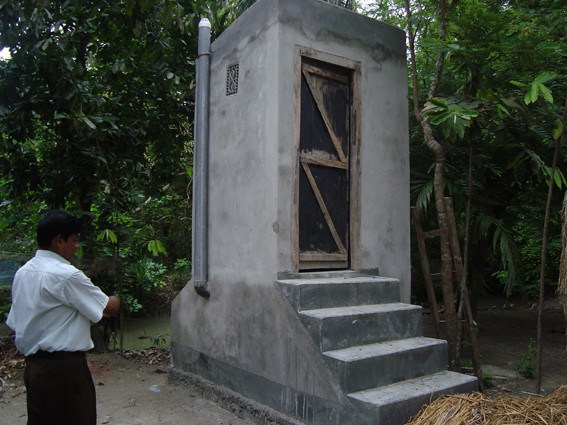Introduction
Current waste management systems in Bangladesh are not adequate to properly handle all of the waste produced by its citizens; in particular, most toilets in Bangladesh do not meet the recommendations set out for improved sanitation by the World Health Organization (i.e., some method that separates feces from humans), and also are not effective in containing waste products in the midst of storms.[1] The increased intensity of coastal storms has created an additional challenge to public health and safety; these storms increase the likelihood of dangerous waste products contaminating important drinking water supplies – especially human waste products which can lead to waterborne diseases such as diarrhea, cholera, typhoid, and dysentery. According to The Water Project, around 60% of the population in Bangladesh lack access to potable drinking water – that is, water which is safe for human consumption.[2] Issues surrounding sanitation and waste management are one factor affecting the scarcity of potable water, and climate change has only served to further escalate these challenges. Samiul Hasan of the University of Queensland highlights the following areas of development for solving problems associated with waste management in Bangladesh: (a) physical planning and facilities; (b) governmental systems and policies; (c) administrative and managerial procedures, and above all, (d) the residents and their attitudes.[1] These issues have compounded Bangladesh, though none of these methods is considered to be “improved sanitation”.[3] Improved sanitation is defined by UNICEF to be “facilities that ensure hygienic separation of human excreta from human contact”.[4] Even the most prevalent form of improved sanitation – the ring slab latrine – is not suitable as a widespread solution.

Figure 1: Ring Slab Latrine. These toilets are preferred to other forms of waste management, but also include some associated risks of groundwater contamination. Source: Coffey/Rice Institute[5]
Solution
One proposed solution to address the waste management problem is Urine Diverting Dry Toilets (UDDTs), which provide many benefits over the present infrastructure (as well as the alternatives which residents have resorted to in light of the lack of proper sanitation systems).

Figure 2: Completed UDDT in Bangladesh. Source: Delepiere[6]
Though the solution itself has much merit in terms of improving the overall condition of waste management in Bangladesh, cost is a large barrier to implementation within Bangladesh. The building and installing of a UDDT costs between $185-$485 USD, compared to ring slab latrines which nearly all people in Bangladesh have access to materials to build.[4] As the cost of an individual system is prohibitive for most households in Bangladesh, a primary source of funding in the past has been nongovernmental organizations (NGOs). The Bangladeshi government has declared a commitment to solving the public sanitation issue, and so the government could be seen as another potential source of funding for creating more UDDTs, potentially as an alternative to traditional public bathrooms. This would be increasingly likely if an NGO were to have great success in a larger scale implementation of UDDTs in Bangladesh than past efforts. However, this is a solution which would take substantial work to plan logistically, and to implement. In addition, government corruption creates another problem in ensuring that funds are properly allocated in the implementation process. We specifically suggest installing UDDTs in schools, similar to a project which was implemented in Kenya via the Ecosan Promotion Project (EPP).[7] Increasing accessibility to improved sanitation in schools will not only decrease the risk of children becoming sick due to exposure to dangerous biological contaminants in water, but it will also help foster more concern for sanitation in future generations. In a study published out of the 4th International Dry Toilet Conference, several UDDT projects were assessed in Kenya in order to ascertain what factors were important for the proper maintenance of these UDDTs. These factors included easy accessibility, privacy and security, ease of cleaning, and affordability.[7] Ensuring these factors are met based on the selected design for each UDDT and implementing proper modifications for each project could greatly increase the likelihood of proper maintenance of new UDDTs installed in schools in Bangladesh.
By Richard Colwell
References
- Samiul Hasan. (1998). Problems of municipal waste management in Bangladesh: An inquiry into its nature. In Habitat International 22, no. 2, 191-202.
- Hedrick, Saima. (2017). Water in Crisis – Spotlight on Bangladesh. The Water Project. Retrieved from https://thewaterproject.org.
- Guadagni, A. (2012). Embedding innovative sanitation technology – An assessment of urinediversion dry toilets in Bangladesh. Retrieved from https://www.susana.org
- UNICEF. Access to water and sanitation: a few definitions. Retrieved from https://www.unicef.org/wcaro/overview_2570.html
- Coffey. (2013). Where people want latrines. Retrieved from http://riceinstitute.org/blog/where-people-want-latrines/.
- Delepiere. (2011). Completed UDDT. Retrieved from https://www.flickr.com/photos/gtzecosan/5634148801/in/set-72157626407064863/
- Pynnönen, K., Tuhkanen, T., Rieck, C., von Münch, E. (2012). Two years after donor funding ended: success factors for schools to keep their urine-diverting dry toilets (UDDTs) clean and well maintained. 4th International Dry Toilet Conference, Tampere, Finland.
